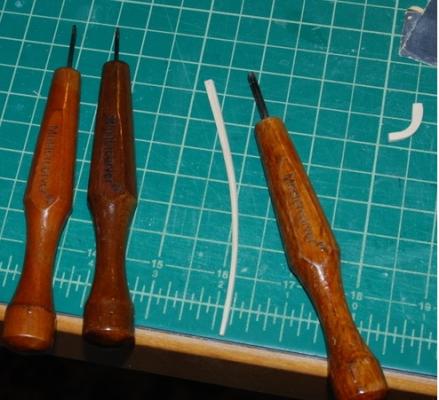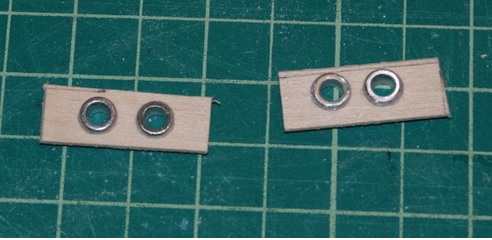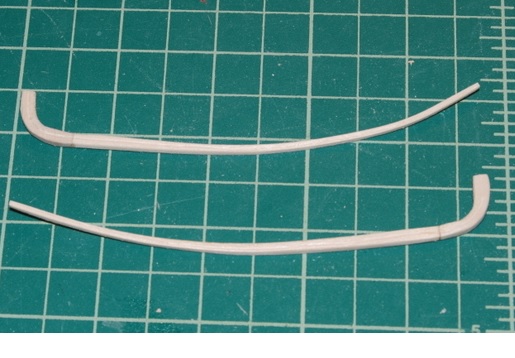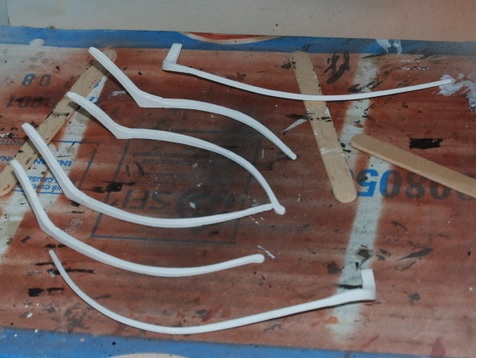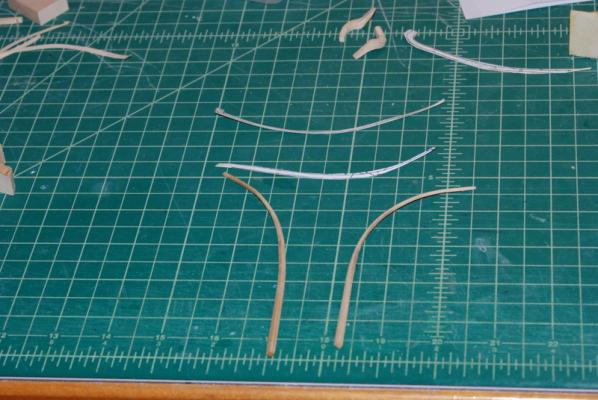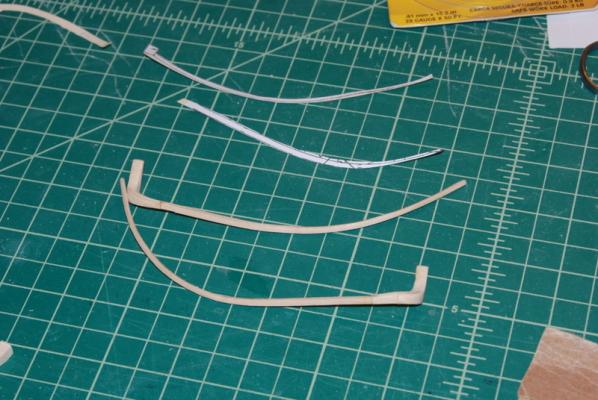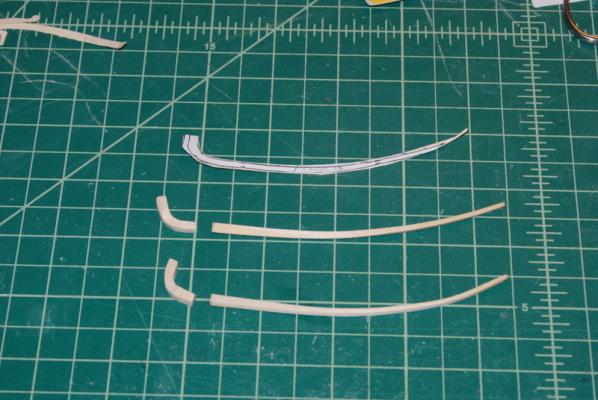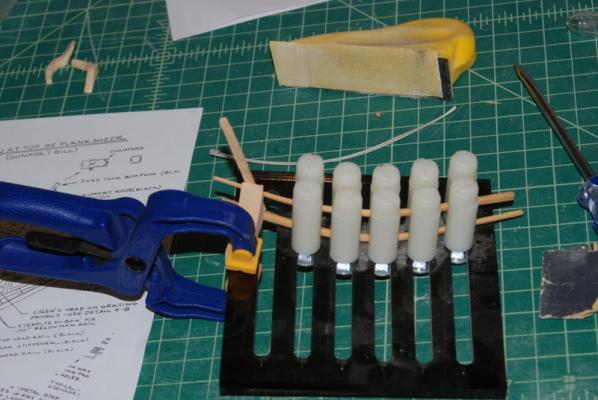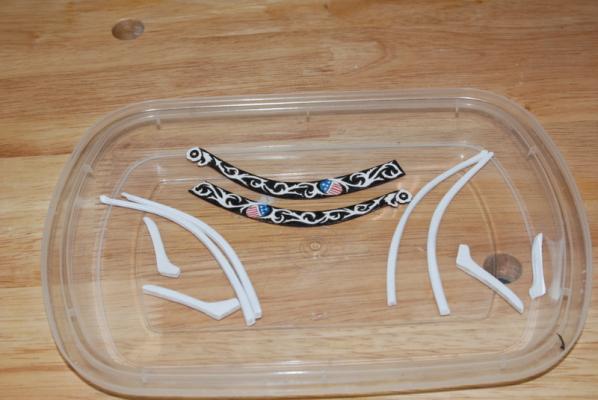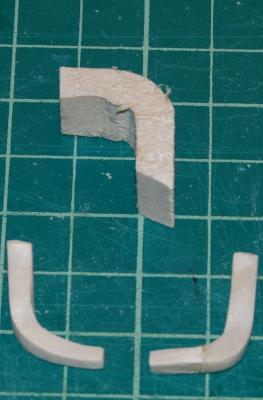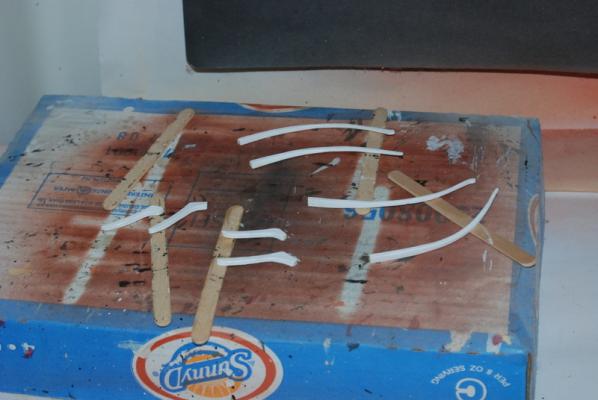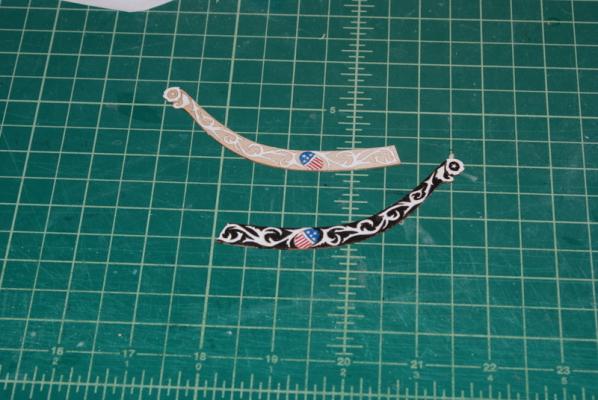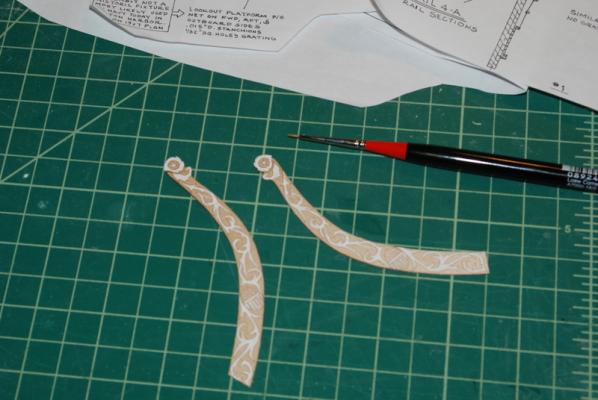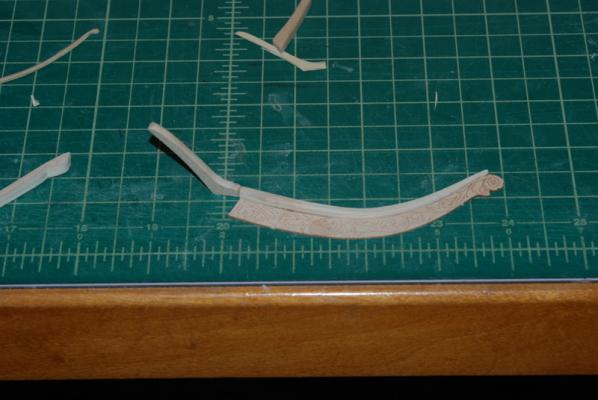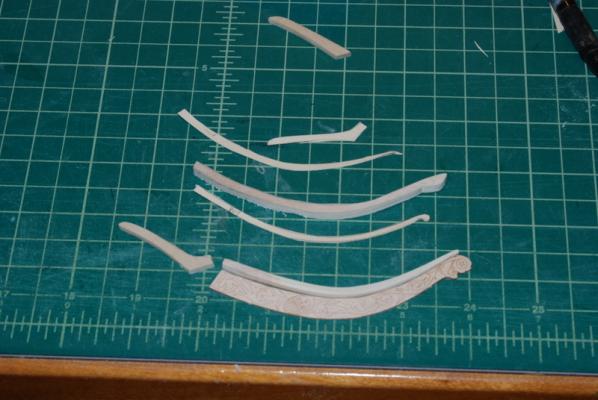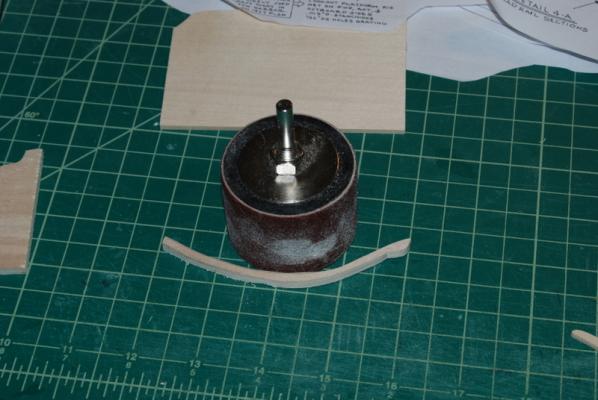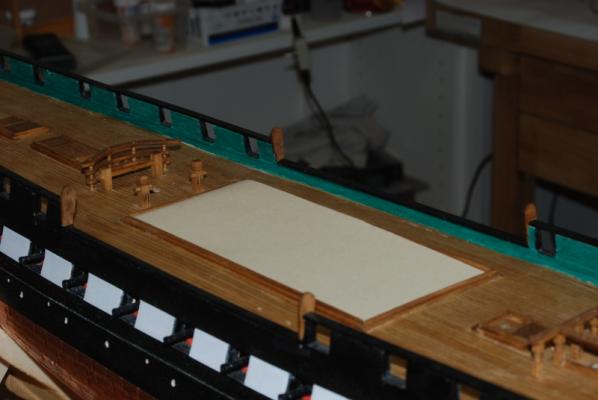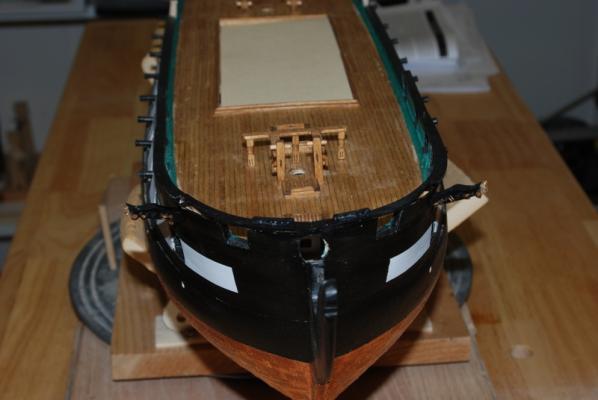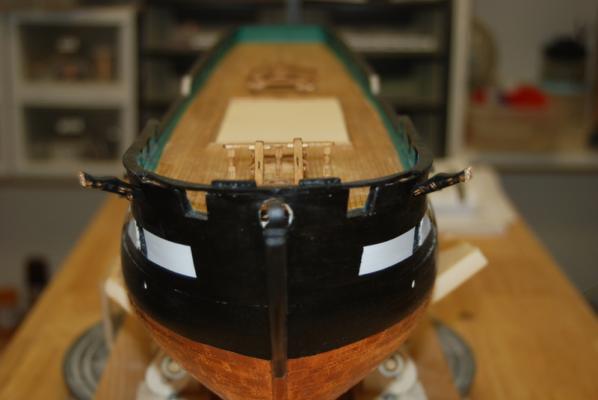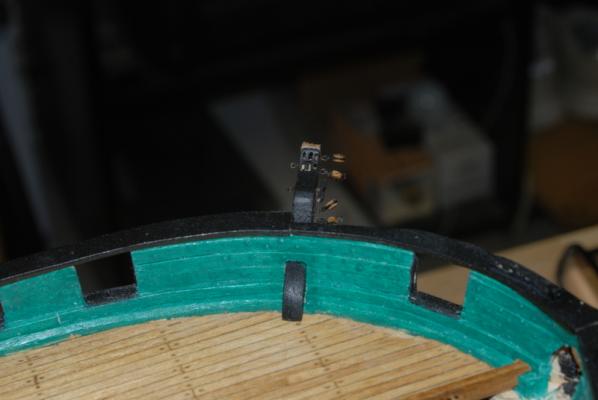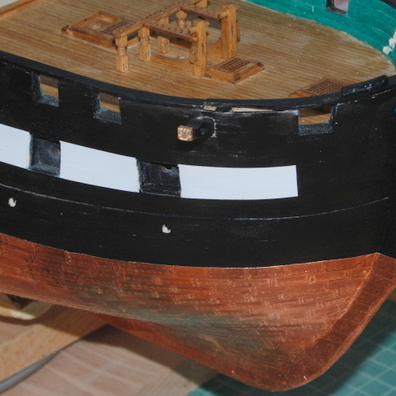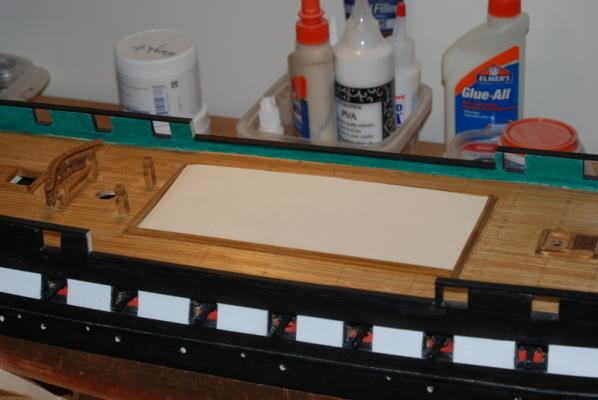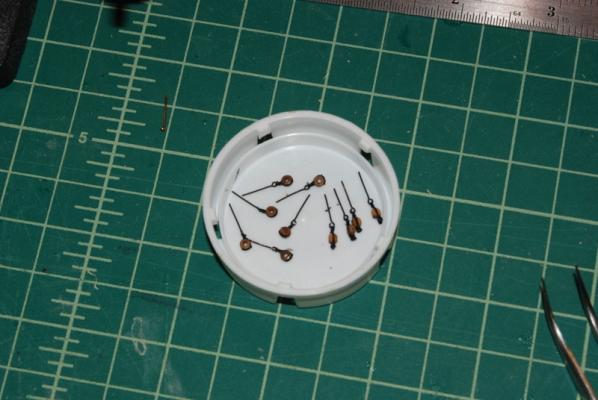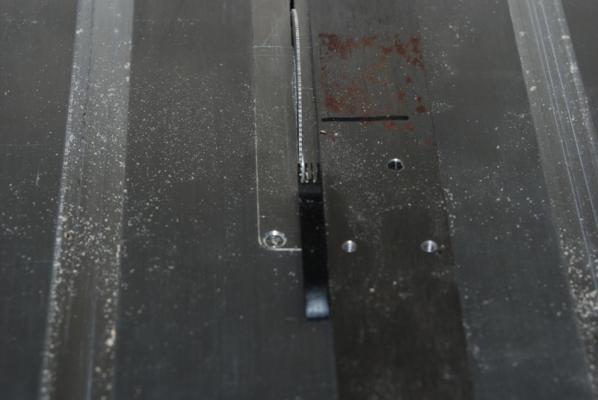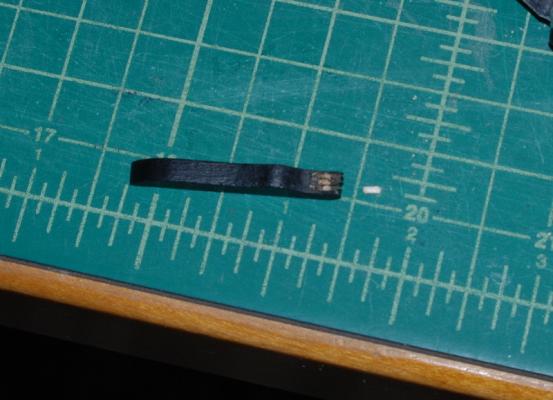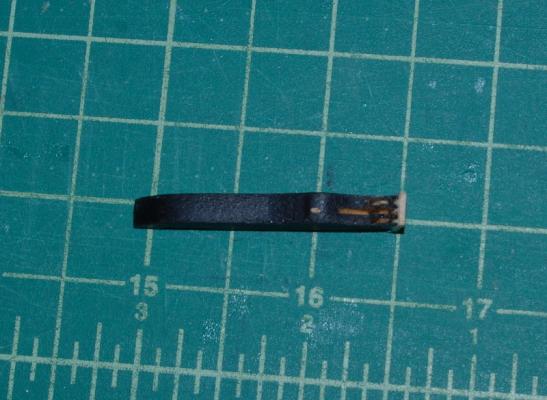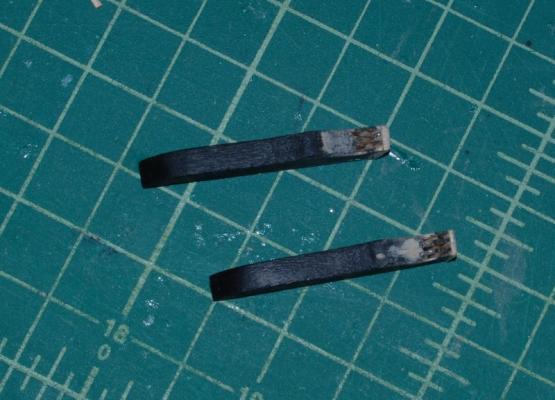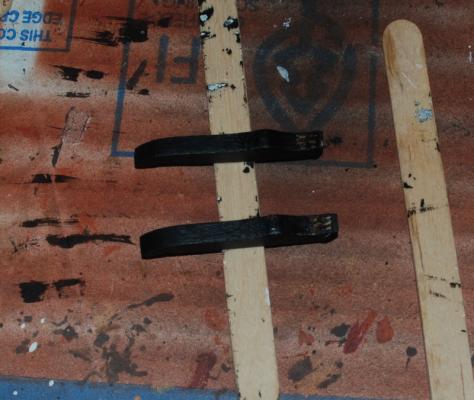-
Posts
2,407 -
Joined
-
Last visited
Content Type
Profiles
Forums
Gallery
Events
Everything posted by usedtosail
-
Great looking sails, Tom. Makes the model really come alive.
- 212 replies
-
- constellation
- artesania latina
-
(and 2 more)
Tagged with:
-
Thanks Mike and Greg, and for the likes. I find building these rails one of the hardest parts of this kit so far. First, a new tool in the mix. I found these 1.5mm carvers which work great. The V shaped chisel is perfect for carving the groove in the rails. I also picked up a straight and a skew, which should come in handy later. I finished making the top middle rails by gluing the two pieces together for each rail and sanding the joint. These now need a coat of primer and two coats of white paint. For the cheek rails, I positioned the trail boards temporarily on the stem and used them to get the lengths of the long pieces of the cheek rails right, then I joined the two pieces of each of the four cheek rails together, using wire as pins to hold the two pieces together with medium CA glue. When that dried, I sanded the joint areas and repainted the white paint around the joints. These are getting close to be ready to install. I also started making the hawse boards which will hold the hawse pipes, which are supplied as white metal pieces in this kit. I cleaned these up using small files and will paint the outsides black and leave the insides unpainted because the white metal looks like lead. I drilled two holes in each trail board while they were still part of a larger thin plywood sheet, then cut them off after filing the holes to the final diameter. I will probably remake these as I think the holes are a little too far apart, but it was good practice. Once the cheek rails are installed, I will fit these hawse boards to sit between them along the hull and drill holes into the hull for the backs of the hawse hole pieces to fit into. I think I will be drilling into the solid wood filler block so I am not sure how deep to go to make it look realistic, but I am thinking probably pretty deep. I will be masking off the trail boards during this process too because I don't want to mess those up now.
- 1,350 replies
-
- constitution
- model shipways
-
(and 1 more)
Tagged with:
-
I would add a scroll saw to that list as the first power tool to buy. I just can't cut curves with anything else, hand or power.
-
This long weekend has been great. I have had lots of time to spend in the shop, as well as with the family. I worked on the two middle head rails, making the end pieces first then the rest of the rail from some tapered stock. I had already made the end pieces for the lower of the two rails and tried bending the rest of the rail in a jig, which worked OK in one direction, but not the other. So, I resoaked the pieces and used my electric plank bender to bend them in both directions at the same time. This worked great. When they dried, I trimmed the large ends and cleaned them up, then carved the groove into the outside faces and rounded over the top and bottom edges. I then glued them to the end pieces, using a piece of wire in holes I drilled in the ends to hold them together, along with some CA glue and wood glue. When these dried, I sanded the joint down, carved the groove into the end pieces, rounded over there outside edges, and gave them a coat of primer. I made the end pieces for the upper middle rail from some sheet stock, then tapered two pieces for the rest of the rail, soaked them and bent them in two direction with the plank bender. That is where I am now.
- 1,350 replies
-
- constitution
- model shipways
-
(and 1 more)
Tagged with:
-
Thanks Steve, Sal, and George, and all the likes. They are much appreciated. I finished up both trail boards so they are ready to be installed with the cheek rails. I also started working on the longer head rails that fit under the cat heads. I started by making two pieces that will go under the cat heads. I did the port side first and basically started making the shape from different pieces of wood. I was able to use it as a template for the starboard side piece, which I was able to make from a single piece of wood. I may go back and remake the port side piece with the blank shown in the pictures, but this one fits really nicely so I am going to wait to see how it looks painted. I am also soaking some strips to use for the rest of these head rails. I am going to try to bend a single piece in two directions for these, but if that doesn't work I will make them from two pieces. I made some templates from the plans for these two rails to make sure I get them the right distance from the stem.
- 1,350 replies
-
- constitution
- model shipways
-
(and 1 more)
Tagged with:
-
Meters?
-
Having made all the pieces for the cheek rails, I gave them a couple of coats of white paint before final assembly on the model. I went with all white for these because I want to use the color scheme on the Hull model for the head rails. I still have to cut the long pieces to length to fit around the trail boards. It is hard to see in this picture, but I did carve a groove down the edges of all these pieces and rounded the outside edges. I would usually use a scraper to make this detail, but the long pieces change widths along their lengths so I thought that would be too hard to keep the scraper centered. So, I used an X-Acto knife to score a line down the center of the edge, then used files to open and deepen the groove, first a triangular file then a round file. What I really should have used is a small V gouge, which I do not own, so that is now on the Christmas list. Sorry for the ugly painting stand in the background. So, since I need the trail boards to install the cheek rails, it was time to try painting them. My back up plan was to cut out paper versions of the white parts and glue them on, so before I started painting I put the trail board pieces in my computer scanner and scanned them. I then used some image editing programs to get black and white versions that I could print and cut out. I could have just copied the plans too, but I thought the lines on the plans were a little too thick. Anyway, I think it was a precaution that is not going to be necessary. I started painting the trail boards by giving them a coat of thinned white paint inside the decorations. I used the smallest brush I have which is shown in the following picture. It reminded me of paint by number kits I did as a kid, but the results looked promising. Of course, this was only one half of the painting and I could deviate from the lines a bit since I could still see the lines after one coat. So I then gave the white areas a second coat. A bit more promising, so I hit the shield with some blue and red paint. I didn't really have a brush small enough to get around those tiny stars on the shield, but a toothpick worked a bit. I may repaint those stars with a brush I cut down to a few hairs. I then went for the gold and painted the starboard side trail board black sections around the other painted sections. I took my time and think it came out pretty well. I have a few areas I want to touch up and I will also give it a second coat of black, but overall I am really happy with the result so far. Now, as usual, I just have to reproduce the results on the starboard side. Happy Thanksgiving to all of you folks in the US.
- 1,350 replies
-
- constitution
- model shipways
-
(and 1 more)
Tagged with:
-
Aw Andy, you beat me to it. I also use those pliers and they work great for me too.
-
I know the feeling Tim. It is hard to wrap my head around all the different curves and angles. The functionality somewhat escapes me too.
- 1,350 replies
-
- constitution
- model shipways
-
(and 1 more)
Tagged with:
-
I glued the hammock boards to the bulwarks at the ends of the open waist. I won't add the small boards that go on top of the rails until I add the hammock cranes much later in the build. I finally got a start on the head details. I started with the cheek knees as suggested in the instructions. I made manilla templates of the parts that sit on the hull and the inside edge of the stem, then cut the top starboard one out of some sheet basswood. I sanded it to get a tight fit on the hull. I then made manilla templates for the two pieces that sit along the stem, but these were too flimsy, so I used the edges of the trail boards to mark the inside edges of these pieces, then the templates to mark the outside edges. I cut them both out roughly on the scroll saw, then sanded the top piece in both directions to get it close to the final shape. I used Jay (Modeler12)'s suggestion to use plywood for these pieces so they don't break while sanding, and it worked out very well. For the inside curves, I used the largest sanding drum I have, but I used it by hand instead of in the drill press. I will sand the other piece tonight and make the bottom piece that goes along the hull, then repeat on the port side.
- 1,350 replies
-
- constitution
- model shipways
-
(and 1 more)
Tagged with:
-
That is some fine work you are doing Sal. She looks great.
- 659 replies
-
- syren
- model shipways
-
(and 1 more)
Tagged with:
-
Hi Greg. Thanks for all the likes. For the decking planks, I gave the planks an initial sanding before installing them. I actually sanded the full length supplied wood strips before cutting off the lengths I needed. I made sure the sides were sanded smooth and straight, and gave the tops and bottoms just a rough sanding. Then I sanded the tops flat after they were all installed.
- 1,350 replies
-
- constitution
- model shipways
-
(and 1 more)
Tagged with:
-
Thank you Nenad. I love what you are doing on your Cutty Sark, especially at that small scale.
- 1,350 replies
-
- constitution
- model shipways
-
(and 1 more)
Tagged with:
-
Greg, I was worried about that too, but I have received some really good advise by doing it. And it is a great feeling knowing that folks like yourself find it useful. I am sure you are doing a great job.
- 1,350 replies
-
- constitution
- model shipways
-
(and 1 more)
Tagged with:
-
Thanks Greg. Do you have a build log? I'd like to follow along.
- 1,350 replies
-
- constitution
- model shipways
-
(and 1 more)
Tagged with:
-
Thanks J and for the likes. We are not quite done with the move in - more to do this weekend, but I did manage to get some time in the shop this week. I ended up re-stropping the blocks for the cat heads, with slightly better results. I then glued the various eye bolts with either blocks, bulls eyes or plain into the cat heads. I then glued the cat heads in place and touched up the areas around the holes with some wood filler and black or green paint. Here are the results: I have also been working on the hammock boards that will go on the ends of the open waists to close off the bulwarks. I cleaned up the kit supplied boards and gave them a coat of oak stain and a coat of wipe on poly. I will glue these on a take some pictures after they are dry. I rearranged the shop so now I have a bench in the middle of the room to hold the model, which I can walk around. I had it on a smaller table on a lazy susan, so I could rotate it, but once I install the bow sprit that would be asking for trouble, since if I rotated it the wrong way the bow sprit would hit the wall. I also put in some nicer shelves for storage, since we found some nice wire shelve that were reasonably priced while looking for shelves for my daughter. It is now time to stop stalling and tackle the head rails. I stared at the plans last night for a while and I think I know how to start, so hopefully I will have some time on Sunday for that.
- 1,350 replies
-
- constitution
- model shipways
-
(and 1 more)
Tagged with:
-
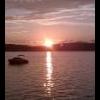
drilling without drill press
usedtosail replied to lionfish's topic in Modeling tools and Workshop Equipment
Lionfish, I had these descriptions in my notes. I am pretty sure they came from posts in MSW 1.0, so if the authors recognize their writing, please acknowledge. Good luck Drilling Mast Holes Cut a block of wood for each mast, and hold them up to the plans aligned with the deck at the mast hole. Mark the locations of the sides of the mast on the top and bottom of the block, then connect these marks to show the mast angle on the sides of the block. Mark the center holes of the masts from the deck plans, then place each block on the deck next to these marks. Use the hand drill to drill small holes for each mast, using the lines on the blocks to hold the drill at the correct angle. Also make sure the drill is aligned port and starboard. Use bigger bits up to 3/16” for each hole. Don’t drill hole same diameter as mast. Drill smaller hole and add tenet to bottom of mast, so mast will hide holes edges. Drilling Mast Holes 2 Actually, you'll find that accuracy of only a couple of degrees is nowhere near enough. Any inacuracy will be greatly magnified by the length of the mast and you'll realise that 1 degree at the deck will mean a deviation of several cm at the tip. Start by making a little jig out of a scrap of timber about half to 3/4 inches wide by an inch high and and half an inch thick. Shape it by hand so it sits on the deck at the mast hole squarely, and cut then file an angle on it, that matches the rake. You need to end up with a block you can sit before or aft of the hole with a face layed back at the correct angle, so that a line drawn down the centre of this face would actually be the imaginary line in the centre of the mast. You can fix the jig to the deck with double sided tape, as it will guide your drill, not support it. Then, line the block with it's marked line up appropriately and using a scribe or pin awl, run it down the line in your jig and push it into the deck, making a good deep hole. This will give you a start for your drill in the correct place at the correct angle. You might not think the angle of an awl hole could make any difference, but believe me it does, since if the angle isn't correct a drill presented into the start you've made will move out of location as it turns. Now using a drill bit somewhere between small and tinsy winsy, in a pin vice or other hand tool that can grip your bit, run it down the line on your jig and hand drill the first very very small hole. Just watch the drill tip as it starts, to make sure it follows the awl hole, then concentrate on the line on your jig, keeping the bit perfectly in line and touching the jig all the time. This will give you a perfect guide hole, which is invaluable. Now step up in drill size. I can't tell you what sizes to use, but if you need say, a 6mm hole, you want to do it in no less than 4 steps. The second step should be no more than a 1mm drill. You'll have to move your jig back now, or it'll push the drill off line, but you don't need to lean on it, just use it as an eye guide. Follow this for all the steps you need until you get to the final hole size and your hole should be perfectly angled. It is important to note, that twist drills (the ones that everybody thinks of when you say drill, that have a screw all the way along the shank), are designed and angle sharpened for metal, not wood. These DO NOT drill an accurate sized hole in timber, since the timber is constantly cut by the side flutes while the drill is cutting its way through the wood. Spade bits are accurate for timber, but far too dangerous to your model, since one slip up and they can rip it to pieces. The solution is to use a normal twist drill bit, that is smaller by about 0.2 to 0.4 than the finished hole you need. If you need say, a 6mm hole, you will finish with a 5.8mm fractional drill, otherwise your hole will be too big. You will need to run the larger drills in a power tool, unless you have enough hands to use a good hand drill. You must make sure that you DO NOT let the weight of the drill rest against the low side of the angled hole as you're drilling, though this is the natural thing to do. If you do, you will get an oval hole and there's nothing you can do to fix it, so make sure you are fully supporting the drill with your own muscle. Multiple sized drills is how I do it too with my last largest drill bit running in reverse that way it never shews up any planking, old woodworking trick. This may seem a little tedious, but accurately drilling small holes in soft wood is suprisingly tricky and this method is sure fire. When you think about it, most times you drill wood, near enough will do, but not on a scale model. There is a high tech and fairly cheap way to know at what angle your hand drill is at, and more importantly what angle the masts will be at. Drilling a perfect hole is not the end all, there will almost always be some play even in a perfect drill. If you drill a slightly larger hole you can buy a set of mast coats which should actually be part of the kit anyway. The high tech tool is a laser. One like the Craftsmen version that shoots a long line. Model Expo also sells a protractor that will make things a bit easier. It has an armature you can set exact to the plans. Make certain the model is level, the laser is level. Set the protractor where the ship will be and the laser to the angle of the setting on the protractor, then slide the ship in place where the protractor was and you've a line to keep the drill in or set the mast to later. The laser has more applications with these models. Yards, center lines down the decks, even a waterline. I got mine as a Father's day gift last year, I've used it on model ships and not a thing else. Today there are a number of cheaper versions of the Craftsmen laser line but be sure you can manipulate the line between vertical and horizontal and you've got what you need. -
Thanks for the likes. I added some trim pieces over the open waist just to cover the long joint at the plank sheer. I made these from the same material as the rails and also painted them black like the rails. Continuing with the cat heads, I did manage to get something that looked like a cat face for the ends (if you squint hard enough). I painted these gold and glued them to the ends, then sanded the edges flush and touched up the gold and black paint. I also added the small cleat on the sides, using a piece of wood that I sanded to the rough shape, then filed into the final shape after it was glued on. This cat head is just set in place and not glued in yet, because I still have to add the eye bolts. I will also have to touch up the joints and black paint around these after they are glued in, although one of the head rails will hide the underneath joint. The plans show five eye bolts on the forward side of the cat heads and two on the aft side. The aft two are for the anchor tackle, so i can just add them empty for now. I checked the rigging plan for what is attached to the five on the forward side, and three of them have bulls eyes and two of them have blocks, all for lines that go to the bowsprit. Instead of trying to strop these to the eye bolts later, I added them now, after cleaning up the blocks so they looked better. I am not happy with the size of the beckets on the blocks, so I will probably redo them to make smaller beckets. I also decided that now was a good time to add the hammock boards to the ends of the open waist, although I have not decided whether to use the laser etched version or carve my own. In any case they will be shorter than the tallest supplied laser cut pieces. I will play around with them next week. I think I am stalling on starting the head rails but I do need to tackle them soon. No work in the shipyard this weekend - we are moving my daughter into her own apartment in NH, since she just got a really good job at a big hospital there. She is getting very close to being off the books.
- 1,350 replies
-
- constitution
- model shipways
-
(and 1 more)
Tagged with:
-
Now that I have the two holes through the bulwarks for the cat heads, I needed to add the details to them. I started with the sieves in the ends. My first attempt was to use the same method I used for the bitts - drill two holes for each sieve and connect them with an awl. Once these were painted black, they really didn't look good, so I went in another direction. I used a slitting disk in the Byrnes saw to cut three slots in the end of each cat head. I then cut small pieces of thin wood and glued them into each slot after rounding the ends. You can see one of these pieces next to the cat head in this picture, but this cat head has all three pieces already in place. I then put some thin CA on the slots to strengthen them, and used the True Sander to sand the ends down so the slots were the correct length. Some of the slots were long in the other direction, so I filled the extra length with wood filler. I then capped the end of the cat heads with a small piece of wood. When it was dry, I sanded the wood piece to sit flush with the sides of the cat head and thinned it a little bit, and also sanded the wood filler. I then repainted them black, and here is how they came out. I should have taken a picture of the first ones to show the difference, but the sieves in these new ones look much better to me. I tried last night to carve two cat head figures onto some strip wood to add to the ends of the cat heads, but the results were laughable. I will give it another go tonight with some different tools and maybe some different wood. I have also finished installing the rail pieces and touched up all the black and green paint around them, and I am in the process of adding trim strips over the plank sheer at the open waist. I was going to leave these natural but after making them I think they will look better black, like the rest of the rails. I'll have a picture of these after I finish painting them and installing them. Next up, after adding the rest of the details to the cat heads and installing them, is the head rails and trim boards.
- 1,350 replies
-
- constitution
- model shipways
-
(and 1 more)
Tagged with:
-
I am looking forward to this build, Bob. I love the small boats you have built in the past and this one looks like a really interesting subject.
- 348 replies
-
- pequot
- cable ship
-
(and 1 more)
Tagged with:
About us
Modelshipworld - Advancing Ship Modeling through Research
SSL Secured
Your security is important for us so this Website is SSL-Secured
NRG Mailing Address
Nautical Research Guild
237 South Lincoln Street
Westmont IL, 60559-1917
Model Ship World ® and the MSW logo are Registered Trademarks, and belong to the Nautical Research Guild (United States Patent and Trademark Office: No. 6,929,264 & No. 6,929,274, registered Dec. 20, 2022)
Helpful Links
About the NRG
If you enjoy building ship models that are historically accurate as well as beautiful, then The Nautical Research Guild (NRG) is just right for you.
The Guild is a non-profit educational organization whose mission is to “Advance Ship Modeling Through Research”. We provide support to our members in their efforts to raise the quality of their model ships.
The Nautical Research Guild has published our world-renowned quarterly magazine, The Nautical Research Journal, since 1955. The pages of the Journal are full of articles by accomplished ship modelers who show you how they create those exquisite details on their models, and by maritime historians who show you the correct details to build. The Journal is available in both print and digital editions. Go to the NRG web site (www.thenrg.org) to download a complimentary digital copy of the Journal. The NRG also publishes plan sets, books and compilations of back issues of the Journal and the former Ships in Scale and Model Ship Builder magazines.



